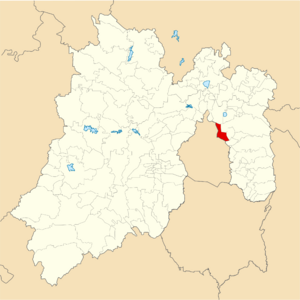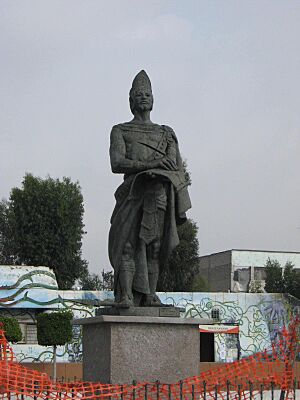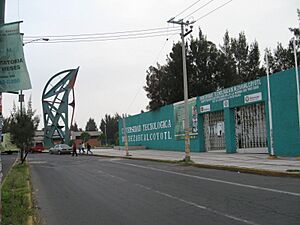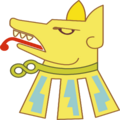Ciudad Nezahualcóyotl facts for kids
Quick facts for kids
Nezahualcóyotl
Ciudad Nezahualcóyotl
|
||
|---|---|---|
|
City and Municipality
|
||

Nezahualcóyotl City Hall
|
||
|
||

Location of the Municipality of Nezahualcóyotl in the State of Mexico
|
||
| Country | ||
| State | ||
| Municipality | Nezahualcóyotl | |
| Municipal Seat | Ciudad Nezahualcóyotl | |
| Municipality founded | 23 April 1963 | |
| Municipal Seat | Ciudad Nezahualcóyotl | |
| Government | ||
| • Type | Ayuntamiento | |
| Area | ||
| • Total | 63.74 km2 (24.61 sq mi) | |
| • Water | 0.62 km2 (0.24 sq mi) | |
| Elevation
(of seat)
|
2,220 m (7,280 ft) | |
| Population
(2020 Census)
|
||
| • Total | 1,077,208 | |
| • Rank | 25th in North America 10th in Mexico |
|
| • Density | 17,026.4/km2 (45,126.6/sq mi) | |
| Time zone | UTC−6 (Central (US Central)) | |
| • Summer (DST) | UTC−5 (Central) | |
| Postal code (of seat) |
57000
|
|
| Area code(s) | 55 | |
| Demonym | Nezahualquense | |
Nezahualcóyotl (often called Neza) is a large city in Mexico. It is located in the State of Mexico, right next to the eastern side of Mexico City. This city is also the main town of the Nezahualcóyotl municipality.
The city is named after Nezahualcoyotl, who was a famous poet and king from the nearby city of Texcoco. His name comes from the Nahuatl language and means "fasting coyote". The city's symbol, or heraldry, includes an Aztec glyph showing a coyote's head with a royal necklace. This symbol was approved in the 1990s.
For a long time, the land where Neza now stands was actually part of Lake Texcoco. It was not until the 20th century that the lake was drained. This created new land for people to live on. However, early settlers did not have basic services like clean water, electricity, or sewers. Nezahualcóyotl became its own municipality in 1963. Today, Neza is a huge city with over a million people. Many residents have moved here from other parts of Mexico.
Contents
How Nezahualcóyotl Began
The city and municipality are named after Nezahualcoyotl, a powerful ruler of Texcoco. Texcoco was a key ally in the Aztec Triple Alliance. The land that is now Neza was under Lake Texcoco until the 1900s. People started draining the lakes in the Valley of Mexico a long time ago. This was done to stop Mexico City from flooding.
By the early 20th century, efforts to fully drain Lake Texcoco continued. In 1912, the lake area became federal property. The government then began selling this new land. The first small towns in the area were extensions of other nearby municipalities.
In the 1940s, people living here started asking for better services. A dam and a tunnel were built in 1945. This helped bring clean water to the first formal neighborhoods. By 1949, about 2,000 people lived in the area. The population grew very fast in the 1950s. Many people came from other parts of Mexico looking for jobs. By 1954, there were 40,000 residents, even without electricity.
In 1960, people suggested making this area a new municipality. It had 80,000 residents by then. This idea became real on April 3, 1963. The state government officially created the municipality of Nezahualcóyotl.
Becoming a municipality helped bring many improvements. Water, paved roads, sewers, and streetlights arrived in the 1960s and 1970s. By the 1980s, important buildings were built. These included hospitals, the city hall, schools, and libraries. The city continued to grow quickly. New neighborhoods and shopping centers were built.
In the 1990s, the Ciudad Deportiva (Sports City) was created. The Universidad Tecnológica de Nezahualcóyotl also opened. By 1995, the city's population was over one million. Neza has also produced many great athletes. One example is Humberto "La Chiquita" González, a famous boxer.
Exploring the City of Neza
Nezahualcóyotl is sometimes called "Neza York." This nickname refers to its huge size and busy city feel. Unlike older parts of Mexico, Neza does not have many colonial buildings.
The city is proud to be home to the Orquesta Sinfónica Infantil y Banda Sinfónica de Nezahualcóyotl. This is a children's symphony orchestra and band. It started in 1998 and has 45 members. They are between 6 and 17 years old. It is the only group of its kind in the State of Mexico. The orchestra has won many awards and performed over 200 times.
Famous Places in Neza
Most buildings in Neza, like the city hall, are modern in design. In front of the city hall, you can find statues of important historical figures. These include Nezahualcóyotl, Cuauhtémoc, and Miguel Hidalgo y Costilla.
Since 2013, Neza has its own cathedral. It is officially called the Cathedral of Jesús Señor de la Divina Misericordia. People usually just call it the Cathedral of Nezahualcóyotl. The cathedral has a chapel, a bookstore, and outdoor altarpieces. These altarpieces show the Lord's Prayer in six different languages.
The main cultural center is the Centro Cultural Jaime Torres Bodet. It opened in 1987. This building has three main areas. On the ground floor, there are workshops and rooms for events. The Bodet Library is on the first floor. On the second floor, you'll find the Nezahualcóyotl Information and Documentation Center. This center collects historical information about the city. Other cultural spots include the José Martín Cultural Center and the Hortus Gallery. The Hortus Gallery is the city's first modern art gallery.
The "José López Portillo" Stadium is better known as the Neza 86 Stadium. It was built in 1981 and reopened for the 1986 FIFA World Cup. The stadium can hold 28,000 people. It is part of the Universidad Tecnológica de Nezahualcóyotl campus. Many soccer teams have called this stadium home. Since 2002, it has been the home of Atlante F.C., a professional soccer team.
The Parque del Pueblo (People's Park) is a large park covering 8.5 hectares. It has an artificial lake, a zoo, and a train for tours. The park opened in 1975. It also features a natural history museum and an open-air theater. The zoo is a highlight, with 260 animals from 57 different species. Many of these species are endangered. The zoo has successfully bred animals like white-tailed deer and Bengal tigers.
The Ciudad Deportiva (Sports City) is a big sports center. It was built in 1990 on the edge of an old landfill. This was the first step in cleaning up the landfill area. It has fields for soccer, baseball, and American football. There are also courts for tennis, basketball, and volleyball.
Fun Water Parks
Nezahualcóyotl has exciting water parks for kids. "El Pulpo" water park opened in 2015. It is one of many public spaces that have been improved in the city. Other water parks include El Barquito and Las Fuentes. These parks are free to enter.
"El Pulpo" water park uses recycled drinking water. This helps save water. The park uses 25 cubic meters of water, which is cleaned and reused. Only a small amount of water is lost each week.
The Old Landfill Transformed
The Bordo de Xochiaca landfill was once one of the biggest landfills in the Valley of Mexico. It covered 150 hectares and operated from the 1970s until 2006. At one point, it was considered one of the dirtiest landfills in the world.
In the 2000s, a big project called Ciudad Jardín Bicentenario began. The goal was to close the landfill and turn the land into something useful. First, the landfill was sealed. About 600 people who lived nearby and sorted trash for a living were moved to new homes.
Next, systems were put in place to manage the gases from the decomposing garbage. Tubes were laid to collect methane gas. This gas is used to produce electricity, which is a great way to use waste. This project also helps prevent a lot of carbon dioxide from going into the air. Rainwater is also collected and reused to water the new grass planted on the site.
This huge project cost a lot of money. Most of the funding came from Grupo Carso, led by Carlos Slim Helú. The Ciudad Jardín Bicentenario now has a shopping mall, a rehabilitation center, and university campuses. It also has federal court offices and a hospital.
The landfill area also includes an expanded Ciudad Deportiva. This sports facility was finished in 2009. It has a large stadium, a cycling track, and many fields for different sports. It also has playgrounds and recreation areas. This project has created thousands of jobs. It helps over two million people in Nezahualcóyotl and nearby areas.
Learning in Nezahualcóyotl
The Universidad Tecnológica de Nezahualcóyotl (UTN) is a technological university. It was created in 1991. The university offers two-year degrees in subjects like Administration, Commerce, and Computer Science. Its campus has great sports facilities, including an Olympic-sized pool and a football stadium.
Another important school is the Facultad de Estudios Superiores Aragón, UNAM. This is part of the Universidad Nacional Autónoma de México. This campus is designed for many students, offering degrees in fields like Architecture, Journalism, and Law. It also has a Computer Center and a Foreign Language Center.
Getting Around Neza
Nezahualcóyotl has good public transportation options.
- Mexico City Metro
- The Line B connects Neza to other parts of the city. Stations in Neza include Nezahualcóyotl, Impulsora, and Río de los Remedios.
- Mexibus
- The Line 3 of the Mexibus system runs through Neza. It connects Pantitlán to Chimalhuacán. There are 25 stations along this line that cross through Nezahualcóyotl.
Neza York and New York Connection
In the past, most people moving to the United States from Mexico came from rural areas. However, since the year 2000, more people from cities like Nezahualcóyotl have been moving to places like New York. These new immigrants are often younger and have more education. This has created a new Mexican subculture called "Neza York." You can see this in their unique style of dress and speech. Businesses like Tacos Neza have even opened in New York City.
The Nezahualcóyotl Municipality
The city of Nezahualcóyotl makes up almost all of the Nezahualcóyotl municipality. About 99.46% of the municipality's population lives within the city limits. It is the second most populated municipality in the State of Mexico. It is also the ninth largest in the entire country. The municipality is located in the eastern part of the Valley of Mexico. It is part of Greater Mexico City.
The municipality covers 63.44 square kilometers. Most of this area (81%) is taken up by the city, which has 86 neighborhoods. The land is mostly flat. The Los Remedios and Churubusco Rivers flow through here. There is also a small part of the original Lake Texcoco remaining. An artificial lake was built in the Parque del Puebla as an ecological reserve.
The climate is mild, with cool winters. Most of the rain falls between June and October. The average temperature is about 15 degrees Celsius. Because the area was underwater for so long and is now very urban, there is not much native wildlife. However, some bird species, like cranes and storks, pass through in winter.
Since Neza is a city, there is no farming here. Livestock production is very small. The economy of the municipality relies mostly on commerce, like shops and businesses. Over 90% of the people work in this sector. The second largest employer is small industries.
Images for kids












